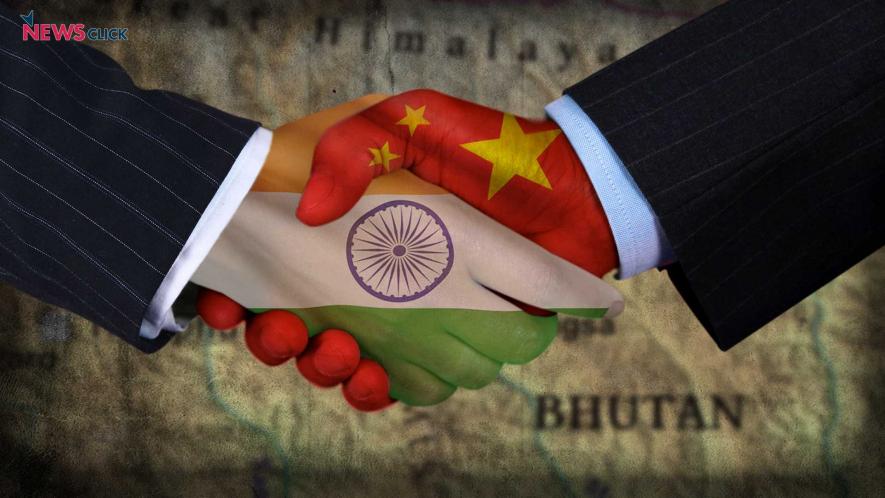India and China: Rivals or Potential Partners in Liberation?

Newsclick Image by Nitesh Kumar
India and China have agreed to end a two-month long military standoff taking place in the the Doklam border region, following the withdrawal of Indian personnel and equipment from territory claimed by China. While India and China have a longstanding history of border conflicts, current tensions take place in the context of India’s growing ties with the United States, and the U.S. military “pivot” to China.
Subordinate alliance with US imperialism
Following India’s neoliberal economic reforms, beginning in 1991, India-U.S. relations have steadily developed closer. In recent years, following the election of Prime Minister Narendra Modi of the far-right, chauvinist Bharatiya Janata Party (BJP), U.S. foreign direct investment in India has shot up 500 percent, coinciding with growing military collaboration. Since 2008, cumulative defense trade has increased from US$1 billion to US$15 billion as India has become world’s largest importer of major arms. The U.S. and India have also designated each other “Major Defence Partners” and signed the Logistics Exchange Memorandum of Agreement (LEMOA), which allows the U.S. to use India’s military bases for repair and replenishment of supplies.
Stronger economic and military ties have resulted in India increasingly aligning itself with US imperialism. Most significant is India’s support for the U.S. strategy of encirclement and aggression against China, which seeks to maintain U.S. unipolar, global hegemony. This has included India’s hosting of the imperialist-supported Dalai Lama, siding with the U.S. position on the South China Sea issue, supporting US aggression against North Korea, and opposing China’s Belt and Road Initiative. During the recent Doklam border conflict, ties between the U.S. and India strengthened as they established a new, bilateral security dialogue which will include their respective defence secretaries and ministers. The U.S. has already established such dialogues with its strategic military allies in the Asia-Pacific region – Japan and Australia.
The main concern of the India-U.S. alliance is targeting China. However, while this partnership deepens, India’s capitalist development at home produces destitution for the majority. Neoliberalism and alignment with U.S. imperialism have exclusively benefited India’s ruling class, now holding approximately 58 per cent of the country’s total wealth, and resulted in increasing inequality and impoverishment for working and oppressed peoples. Marxist economist Utsa Patnaik has demonstrated that per capita food consumption in India is decreasing and absolute poverty is rising. This has resulted in 35 percent of rural adults being undernourished, and 42 percent of children being underweight. It is clear that India’s people require a new way forward, as the current capitalist, U.S.-friendly path does not meet their needs.
China and a different path for development
In 2004, socialist revolutionary Fidel Castro declared that “China has become objectively the most promising hope and the best example for all Third World countries.” Although often portrayed as a “rival” by India’s ruling class elites and corporate media, India’s working and oppressed peoples do not benefit from the anti-China orientation. Rather, learning from China’s experiences and developing mutually beneficial relations can support their struggle forward.
Having both been oppressed by the West for centuries, India and China have faced similar challenges of pursuing national development and addressing the needs of immense populations in the hostile environment of world capitalism and imperialism. However, they have pursued distinctly different paths: capitalism and socialism, respectively. By comparing how the two countries have responded to these challenges, insight can be gained about how the Indian people can advance their interests.
(i) Poverty and exploitation
In India, capitalist development has left the vast majority in a severe state of deprivation. India is home to the world’s largest poverty-stricken population and the figures are staggering: approximately 270 million Indians, or 21.2 percent, live on less than US$1.90 per day, and 732 million, or 58 percent, live on less than $3.10 USD per day. Deep cuts in government support for peasant, agriculture and trade liberalisation which triggered severe price crashes have led to over 300,000 farmer suicides since 1995. Further, the unemployment rate grew from 6.8 percent in 2001 to 9.6 percent in 2011 and permanent jobs are giving way to temporary and casual work. This has adversely affected workers’ wages and social security, leading to India’s central trade unions calling for an indefinite general strike later this year.
Conversely, in China living conditions are consistently improving. In the past four decades alone, China has lifted over 800 million people out of poverty, more than the rest of the world combined, as the Communist Party works to eradicate poverty by 2020. Only 1.9 percent of China’s population lives below the international poverty line, compared to over one-fifth of India’s population. Chinese wage growth is soaring, with hourly manufacturing wages rising 12 percent per year since 2001. Across China’s labour force as a whole hourly incomes now exceed every major Latin American state except for Chile, and are approximately 70% of levels in weaker eurozone countries. Additionally, income inequality, which is rising globally, has been steadily decreasing in China since 2010. A 2013 Pew Research Centre survey supports these findings, reporting that 85% of China’s population were satisfied with the direction of their economy, and 82% believed their children would be better off than them, both figures being the highest in the world.
(ii) Oppression and discrimination
Indian society is branded by the oppressive caste system of social hierarchy and Hindu supremacist ideology. Oppressed castes, indigenous Adivasi peoples, and religious and national minorities face systemic discrimination and violence. The current BJP-led government, promotes violent racism and hatred, leading to increasing attacks on oppressed peoples.
In contrast, China explicitly stresses the importance of multinational unity and of combating chauvinism, particularly of the Han majority. China systemically supports the development of national minorities. For example, urban, eastern provinces send hundreds of thousands of youth volunteers and spend 3-5% of their total income supporting western provinces which are more densely populated by national minorities.
Although both countries have far to go, China is also significantly ahead of India in the struggle against patriarchy. China’s adult women’s literacy rate is 94.5 percent, compared with India’s rate of 63 percent. China’s women to men, labour force participation ratio, at 0.81, more than doubles India’s, at 0.34. Similarly, Chinese women’s political participation, at 24.2 percent, is more than twice India’s, which is at 11.8 percent.
(iii) National development and liberation from imperialism
While India recently observed its 70th anniversary of independence from British rule, the country remains subordinated to imperialism and severely underdeveloped. India has the worst access to safe-drinking water in the world, and approximately 240 million people do not have access to electricity. One in six urban Indians lives in slums and from 2010-2014, an average of 7 structures collapsed per day killing 13,178 people.
In comparison, China has experienced unprecedented economic development and is now the second most powerful economy in the world. Since 1978, China has pursued a policy of reform and opening up of its economy, contrasting sharply with Indian neoliberalism. China’s market reforms are firmly controlled by the socialist state and implemented to overcome the underdevelopment historically imposed on China by Western imperialism.
China is building a modern, moderately prosperous society, spending more on infrastructure than the US and Europe combined. One hundred percent of the population has access to electricity and China spends hundreds of billions of dollars on water clean-up projects. Further, China is committed to environmental sustainability and fighting the climate crisis, leading the world in renewable energy production and employment, powering regions on 100 percent renewable energy for one-week trial periods, and undertaking one of the most ambitious conservation projects in the world to halt environmental degradation.
Internationally, China works in cooperation with oppressed nations throughout the Global South, providing beneficial alternatives to imperialism. China offers investment, builds infrastructure, forgives debt, and abides by the principle of non-interference in the internal affairs of other countries. Close relations with China have benefited revolutionary states and oppressed nations around the world, including Cuba, Venezuela, Syria, and North Korea. A key example of China’s global impact is the Belt and Road initiative, which has been called “the largest single infrastructure program in human history”, currently involving 68 countries and 1700 development projects.
China is the primary force building a multipolar, more democratic international order, ending 500 years of Western imperial dominance. As such, China’s rise supports the liberation of all peoples oppressed by imperialism.
Liberation lies to the East
It is difficult to overstate the magnitude of Chinese socialism’s achievements relative to India’s capitalist path in pursuing development and improving living standards. India’s people would benefit substantially from ending hostilities with China, learning from Chinese socialism, and developing a mutually beneficial relationship. Accounting for over one-third of the world’s population, India and China have the potential to form “the most significant bilateral relationship of the 21st century,” as Chinese Premier Li Keqiang stated in 2012.
Conflict with China offers nothing to India’s workers, peasants, and oppressed peoples. Only by breaking with US imperialism and the domestic capitalist ruling class, will India’s people begin their journey from formal independence toward liberation.
A condensed version of this article was originally published by teleSUR (August 31, 2017)
Ajit Singh is a Marxist, anti-imperialist writer and activist. He received his Juris Doctor in Law from the University of Western Ontario in 2014. Follow him on Twitter.
Disclaimer: The views expressed here are the author's personal views, and do not necessarily represent the views of Newsclick.
Get the latest reports & analysis with people's perspective on Protests, movements & deep analytical videos, discussions of the current affairs in your Telegram app. Subscribe to NewsClick's Telegram channel & get Real-Time updates on stories, as they get published on our website.
























